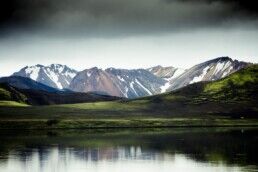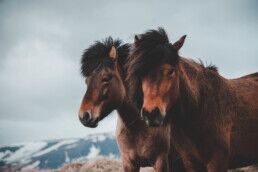About The Icelandic Highlands
By Michael Chapman
It’s time to discover Iceland’s wildest region…
About The Icelandic Highlands
By Michael Chapman
It’s time to discover Iceland’s wildest region…
Iceland’s largest and innermost region is a vast plateau of glacial mountainsides, geothermal springs and untameable wilderness.
Of course, most of the Highlands constitutes empty black desert, which in many ways, is as striking as the scenery around it.
Despite these dark plains being subject to glacial flooding, water filters through the rock so quickly here that plant-growth is impossible. The lush and green areas famous in travel photographs are normally found along rivers that run from the plateau’s highest elevations.

Aside from its natural splendour, the Highlands are revered for their place in history, having served as a crucial trading pass for many centuries.
However, the inhospitality of the land has meant that Icelanders never chose to settle their country’s highest plateaus, instead remaining on coastal settlements where food was plentiful and the weather more temperate.
The Highlands lack the infrastructure of Iceland’s more widely trodden tourist trails, making it impossible to explore the area in winter without the leadership of a professional guide.
Top locations in the Icelandic Highlands
Despite their relative inaccessibility during Iceland’s winter, the region is home to countless attractions worthy of any explorer’s appreciation.
Landmannalaugar

In Icelandic, Landmannalaugar translates to ‘Pools of the People’. This name can be traced to the many naturally-formed geothermal pools that dot the region; bubbling hot pots that served warm relief both for the shepherd’s flock, and the shepherd himself, in bygone times.
Today, tourists have taken their place, so for that reason, it’s always a good idea to bring along a towel should you find one of these pools during your visit.
Landmannalaugar is famed for its rhyolite hillsides; shingly slopes that reflect the passing sunlight, and appear to shift in colour accordingly. This dazzling spectacle is enough reason to pay Landmannalaugar a visit, though there are many other attractions nearby, including Mount Brennisteinsalda and Bláhnjúkur volcano.
PLAN YOUR JOURNEY
Travelling to Iceland?
Check our overnight tours with a driver guide that includes a one night stay in a bubble.*Starting from ISK 74.900 per person
Thorsmork

Named after the Norse God of Thunder, this dramatic Highlands oasis is entirely surrounded by glaciers and mountains. In fact, it is located directly between the glaciers, Tindfjallajökull, Mýrdalsjökull and Eyjafjallajökull, making for impressive framing to any viewpoints you come across.
Thorsmork serves as the beginning of the day-long Fimmvörðuháls hiking trail, a gorgeous and beginner-friendly route that sees its guests arriving in the tiny village of Skógar.
Maelifell

Maelifell is a photographer’s dream. A cone-shaped mountain that rises from the empty black dunes around it, its slopes are covered with a thick green moss during the summer, creating fantastic colour tones. In the winter months, however, the mountain stands above all else like a towering stalagmite of ice.
If you want to learn more about this fascinating mountain, make sure to read our feature article Mælifell Volcano | Secret Treasures of the Icelandic Highlands.
Herðubreiðarlindir
Even though Herdubreid is a feast for the eyes, it is not considered among Iceland’s most famous mountains. This lack of appreciation must be due to its remote Highlands location rather than its dramatic aesthetic; steep slopes rise up to a wide rocky plateau, a mountain seemingly inspired by the mythic locations found in Norse Mythology
Officially, Herdubreid is a tuya mountain, and is located as part of Vatnajökull National Park. Icelanders will often refer to it as ‘The Queen of Icelandic Mountains’ due to its striking form, and indeed, it has sheltered numerous outlaws over the island’s 1000 years of settlement.
Visitors here will have fantastic views of Ódáðahraun desert, and will also have a chance of seeing Askja volcano, if they’re willing to make a short detour,Surrounded by the oasis of Herðubreiðarlindir, the area is great for camping, as well as visiting Vatnajökull National Park to the south.
Top Activities in the Icelandic Highlands
Sightseeing is the main reason why people choose to visit the Icelandic Highlands, bolstered by the opportunity to snap some incredible photographs of their experience.
However, there is a wealth of other activities to keep one entertained in the Highlands, and partaking in any of them is sure to heighten your time in the area.
Snowmobiling in the Icelandic Highlands

If there is one activity that’s sure to get the heart-racing wherever it takes place, it’s taking a snowmobile and speeding off towards the horizon. It just so happens that the wide valley of Thorsmork makes for one of the most visually striking environments in Iceland, adding a litany of reasons why you should choose to snowmobile there rather than elsewhere.
At certain points during your snowmobiling tour, your guide will pull everybody over to dismount their snowmobiles and appreciate various sights enroute. Among the most extraordinary is the extinct volcano Einhyrningur, or Mt. Unicorn, named after the large, horn-like protrusion that rises from its slopes.
If mountains don’t tickle your fancy—and if not, why not?—then perhaps the gargantuan gorge, Stakkholtsgjá, will satisfy. With towering cliff sides that seem to drop without end, you’ll quickly realise just how high up you are in comparison to the rest of your time in the land of ice and fire.
If you’re not one for heights, then fear not; you’ll be back snowmobiling in no time!
Hiking the Laugavegur trail

The Laugavegur trail shares a name with Reykjavik’s most busy shopping street, which can cause a little bit of confusion when planning a hiking trip. If you find yourself, walking-poles in hand, stomping purposefully past a variety of Puffin-themed souvenir shops, restaurants and bars, you’ve arrived at the wrong place and should act accordingly.
The actual Laugavegur trail is far more remarkable, least of all because of the challenge it provides, and more due to the spectacular scenery from beginning to end.
Open between June and September each year, one can expect a well-marked route with enough foot traffic that getting lost along the way would be quite the feat.
Covering 55 kilometres in total, Laugavegur boasts eclectic natural highlights, from raging river rapids to gnarled lava fields and stretches of obsidian emptiness.
Note that the Laugavegur trail can take anywhere between 3-8 days to hike, depending on your speed and level of physical fitness. This distance makes Laugavegur longer than the nearby Fimmvörðuháls pass mentioned above.
There are currently six overnight cabins that are operated by the Iceland Touring Association, Ferðafélag Íslands, making it easy to rest up at the end of each day.
Horse riding in the Highlands

Another brilliant method of experiencing the Icelandic Highlands is from atop the saddle. Frankly, Icelandic horses are the only means of transportation that can compete with the 4x4s so commonly spotted around the island as these miraculous and genetically pure animals have become well-adapted to the environment over preceding centuries.
Icelandic horse tours are as suitable for beginners as they are experienced riders, and you’ll find your guides will help you and your steed to keep a pace that fits your skill level.
Driving in the Icelandic Highlands

Summer visitors are free to explore the Icelandic Highlands as part of their holiday, but they must remember a few crucial facts before they do so.
First of all, a 4×4 vehicle should be considered critical to your journey. If you consider this point dismissable, expect to find yourself trapped in the middle of nowhere, struggling to secure a network connection on your phone so as to call the rescue services.
All roads in the Highlands are gravel and mountainous thoroughfares that normal cars are simply not able to conquer. On top of that, there are countless ridges and river crossings that pose a challenge, even to the most experienced driver-guides.
Have you ever wondered why you see so many Superjeeps and large-wheeled titan wagons when travelling around Iceland? Rugged terrain like that found in the Icelandic Highlands is the exact reason why.
PLAN YOUR JOURNEY
Travelling to Iceland?
Check our overnight tours with a driver guide that includes a one night stay in a bubble.*Starting from ISK 74.900 per person